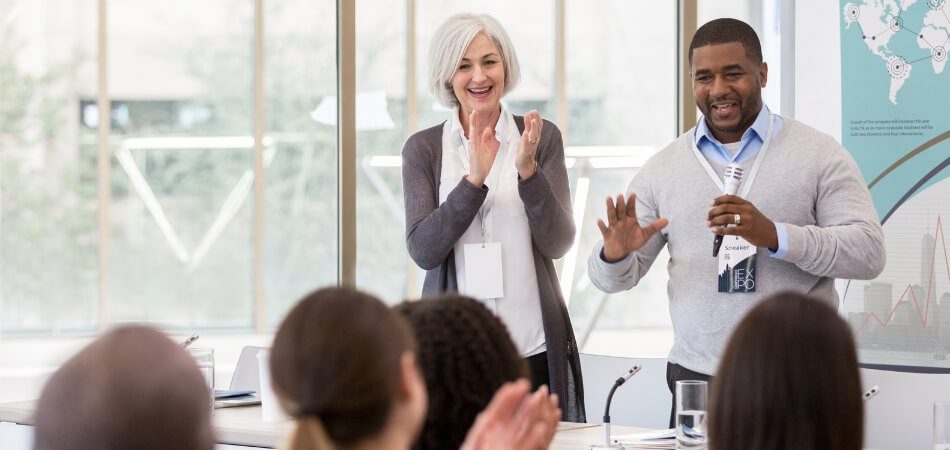Keynote speakers are often the highlight of a conference. They set the tone, inspire the audience, and bring focus to the program. When people think about planning events, one thought often comes to their mind: how many keynote speakers can be in a conference?
Most conferences have one keynote speaker; larger events may include two. Rarely, very large multi-day events feature three or more. The ideal number depends on the event’s goals, size, and budget, with fewer keynotes offering stronger focus and clearer messaging.
Do you want to know what factors help you decide the right number of keynote speakers? In this article, you will find clear information on goals, timing, budget, audience needs, and how to balance everything for the best outcome.
How Many Keynote Speakers Can Be in a Conference?
Planning a conference involves giving special attention to keynote speakers, as they play a big role in shaping the program. They set the mood, highlight important points, and bring energy to the event. The number of keynote speakers can vary depending on the event style and goals.
Common Practice
Most conferences usually have one keynote speaker. This person often opens the event and sets the main tone. Some multi-day conferences use two, one at the start and another at the end. Having three or more keynotes is rare and happens mostly at very large events.
Event Goals
If your event needs a single, powerful message, one keynote speaker works best. But if you want to show different points of view, you may choose two keynotes. The right number depends on whether you want unity or multiple perspectives to guide the audience.
Event Length
The duration of the event is a big factor. Short, one-day events usually stick with one keynote. If the event runs across two or more days, two keynote speakers are a good choice. For example, an international conference in Canada, the USA, Australia, or any other country that spans several days might even add a third keynote, but this is uncommon and works only for very large programs.
Audience Needs
Think about what your audience can handle without feeling overwhelmed. Too many keynote speeches can make the program feel heavy. Most audiences prefer one or two keynote sessions so they can focus on key ideas without getting overloaded with too much content.
Budget Limits
Keynote speakers can be costly, so the budget often decides the number. Many organizers prefer hiring one strong keynote speaker instead of spreading funds across several. This way, you save money and still give your audience a powerful and memorable experience.
Engagement Level
One keynote speaker keeps the event focused and united. With two, you can add variety and balance by having one at the beginning and one at the end. More than that can reduce impact, as too many voices may divide audience attention.
Event Size
Large conferences with thousands of attendees sometimes feature more keynote speakers, especially when the event runs for several days. Smaller and mid-sized events usually don’t need more than one or two. Matching the number of keynotes to event size makes the program flow better.
Message Clarity
Keynotes should leave a strong impression. Having too many can blur the main message. One or two keynote speakers make it easier for the audience to remember the core ideas. Keeping the number small often leads to a clearer and stronger outcome.
Audience Energy
Keynotes are often long and filled with details. Too many can tire the audience and reduce excitement. One or two keynotes usually keep energy levels high. This helps the event end with the same strength it started with.
Most conferences work best with one keynote speaker, while some use two for longer programs. Three or more are rare and fit only large events. Choosing the right number depends on goals, event length, audience size, and budget.
How to Choose the Right Number of Keynote Speakers for a Conference?
Planning the right number of keynote speakers is not always simple. Different events need different approaches, and what works for one may not fit another. There are a few key points that can guide you in making this choice.
Event Schedule
The schedule plays a big part in deciding how many keynote speakers in a conference are ideal. A one-day event usually works best with one speaker, while multi-day conferences often benefit from having one at the start and another at the end to frame the event.
Audience Interest
Think about what the audience will find most engaging. Too many keynote speeches can make people tired and less focused. Choosing the right number makes sure the audience gets the main ideas without feeling weighed down by too much information.
Budget Planning
Keynote speakers often charge high fees, so the number you choose has to match your budget. Many events do best with one or two keynote speakers. This way, you get a strong impact while keeping costs under control.
Overall Impact
The role of keynote speakers at conferences is to set the tone, so the number you choose should match the overall goals of your event. A smaller number often creates a stronger and more memorable effect, while too many can dilute the message.
Picking the right number of keynote speakers is about balance. By matching them with your goals, schedule, audience needs, and budget, you can create a conference that feels focused, powerful, and easy for people to connect with.
What Speaker Mix Works Best if I Have More Than One Keynote?
Events with more than one keynote speaker require careful balance to ensure harmony. Each speaker brings a unique style, message, and energy. Combined effectively, they can leave a strong and lasting impact on the audience. Thoughtful scheduling and clear themes help maximize the value of having multiple voices on stage. To see how this balance works, here are the key roles to consider:
Opening Speaker
The opening keynote sets the stage for everything that follows. This person often introduces big ideas, highlights trends, and excites the audience. Their role is to grab attention right from the start and build momentum for the rest of the event.
Mid-event Voice
A speaker in the middle of the event usually brings a practical side. They might share personal stories, real experiences, or case studies. This style keeps the audience connected and gives them useful examples they can relate to during the sessions.
Closing Inspiration
The final keynote is often the one people remember most. This speaker should leave the audience motivated, with a sense of purpose and energy. They tie the lessons together and inspire everyone to take action beyond the event itself.
Blending Styles
When you book a keynote speaker, think about how their style and topic will blend with others to create the right mix. A good combination might start with a trend setter, move to a practitioner, and close with an inspirational speaker.
Audience Impact
The right mix of speakers keeps the event balanced. It avoids repeating the same tone and gives the audience different ways to stay engaged. By choosing wisely, organizers can create a program that feels fresh, exciting, and meaningful all the way through.
A mix of different speaker styles works best when you have more than one keynote. Opening strong, adding a practical voice, and closing with inspiration ensure the event leaves a powerful mark on everyone who attends.
What Should a Keynote Speaker Invitation Email Include?
Inviting a keynote speaker is an important step when planning an event. A well-written email shows respect, creates interest, and sets the right tone. Knowing what to include helps you write an effective invitation that gets attention.
- Subject Line: Make it short, clear, and engaging so the speaker knows right away the email is about an invitation to your event.
- Greeting: Address the speaker by name and use a polite, warm tone that shows professionalism while making them feel valued.
- Introduction: Briefly introduce yourself and your organization so the speaker understands who you are and why you are contacting them.
- Event Details: Share the event name, date, location, and audience type, giving the speaker a clear picture of the opportunity.
- Role Description: Explain what you would like them to do, such as delivering the keynote, setting the tone, or closing the program.
- Benefits: Highlight how speaking at your event could benefit them, such as audience reach, networking chances, or publicity opportunities.
- Closing: End with thanks, clear next steps, and your contact information so the speaker can reply easily without confusion.
Here’s a sample email you can use:
Subject: Invitation to Speak as Keynote at Our Upcoming Conference
Dear [Speaker’s Name],
I hope this message finds you well. My name is [Your Name], and I am writing on behalf of [Organization/Conference Name]. We are organizing [Event Name], scheduled to take place on [Date] at [Venue/Location].
We would be honored to have you join us as our keynote speaker. Your expertise in [specific field/topic] makes you an ideal fit to inspire our audience of [audience type, e.g., professionals, industry leaders, or community members].
The keynote session is planned for [specific time or day], and we would love for you to share your thoughts on [suggested topic or theme]. We believe your perspective would add great value and set the tone for the event.
In addition to speaking, you’ll have the opportunity to connect with [audience size/type] and engage in meaningful discussions with other notable participants.
Please let us know if you are available to join us. I would be happy to share more details and discuss any requirements you may have.
Thank you for considering this invitation. We truly hope to welcome you as a keynote speaker at [Event Name].
Warm regards,
[Your Full Name]
[Your Role]
[Organization Name]
[Phone Number]
[Email Address]
A strong invitation email makes a positive impression and shows respect for the speaker’s time. Clear details, polite tone, and direct communication increase the chance of receiving a positive and encouraging response.
How to Keep Balance Between Keynote Speaker and Breakouts in a Conference?
Every conference needs the right mix of inspiration and interaction. Keynote speakers set the stage, while breakout sessions give space for deeper talks. The balance between these two creates a smooth event. Let’s look at how you can achieve this.
Limit Keynotes
Too many keynotes can make the event feel heavy. One or two strong keynote sessions are usually enough to create energy and highlight the main ideas, leaving enough time for other parts of the program that keep the event balanced.
Time Control
Keeping keynote talks short makes them more engaging. Around 40 minutes is a good limit, as it holds attention while leaving space for interaction. Longer speeches often risk tiring the audience, so shorter, focused talks work much better overall.
Space for Breakouts
Breakout sessions allow smaller groups to discuss, share, and learn. These sessions bring practical value and encourage audience participation. By giving strong blocks of time for breakouts, attendees feel more involved and walk away with useful ideas they can apply.
Networking Time
Conferences are also about people connecting with each other. Scheduling breaks between keynotes and breakout sessions helps participants relax and interact. Networking time adds value because attendees share experiences, exchange ideas, and build meaningful connections outside the main sessions.
Smooth Flow
A good balance comes from planning the order of sessions carefully. Starting with a keynote, moving into breakouts, and closing with another keynote keeps the rhythm strong. This flow gives both inspiration and discussion without overwhelming or boring the audience.
Balancing keynotes and breakouts ensures conferences stay engaging and productive. Limiting speech length, leaving space for interaction, and adding networking opportunities create an event that feels smooth, impactful, and rewarding for everyone who attends.
Simple Agenda for Conference Keynote Speaker
Planning a conference schedule becomes easier when you break down sessions into minutes. It shows exactly how much time each part of the program takes, making it simple to balance keynotes, breakouts, and networking. Here’s a clear layout.
| Single-Day (1 Keynote) | Two-Day (2 Keynotes) | Three-Day (3 Keynotes) |
| Opening Keynote – 40 min | Day 1 Opening Keynote – 40 min | Day 1 Opening Keynote – 40 min |
| Coffee Break – 20 min | Coffee Break – 20 min | Coffee Break – 20 min |
| Breakout Sessions – 120 min | Breakout Sessions – 120 min | Breakout Sessions – 150 min |
| Lunch – 60 min | Lunch – 60 min | Lunch – 60 min |
| Breakout Sessions – 120 min | Workshops / Panels – 120 min | Workshops / Panels – 120 min |
| Coffee Break – 30 min | Coffee Break – 30 min | Coffee Break – 30 min |
| Day Recap / Q&A – 30 min | Breakout Sessions – 90 min | Breakout Sessions – 60 min |
| Networking / Closing – 60 min | Networking Reception – 60 min | Networking Mixer – 120 min |
| — | Day 2 Breakouts – 120 min | Day 2 Breakouts – 120 min |
| — | Coffee Break – 30 min | Coffee Break – 30 min |
| — | Roundtables – 90 min | Mid-event Keynote – 30 min |
| — | Lunch – 60 min | Lunch – 60 min |
| — | Breakouts – 90 min | Panels / Workshops – 180 min |
| — | Coffee Break – 30 min | Coffee Break – 30 min |
| — | Closing Keynote – 40 min | Case Studies – 90 min |
| — | Wrap-Up – 20 min | Networking Dinner – 90 min |
| — | — | Day 3 Breakouts – 120 min |
| — | — | Coffee Break – 30 min |
| — | — | Roundtables – 90 min |
| — | — | Lunch – 60 min |
| — | — | Panel Debate – 60 min |
| — | — | Coffee Break – 30 min |
| — | — | Closing Keynote – 40 min |
| — | — | Final Remarks – 20 min |
By breaking it into minutes, you can clearly see how much time is given to each activity. This makes it easier to design a balanced conference where keynote speeches, learning, and networking all fit smoothly together.
How to Avoid Topic Overlap Between Keynote Speakers in Conferences?
Planning multiple keynote speakers requires ensuring that each voice adds something fresh. Overlapping topics can confuse the audience and weaken the event’s impact. With careful coordination and clear communication, speakers can deliver unique perspectives that keep the program engaging. Let’s see how.
- Clear Theme: Assign each speaker a unique theme so they focus on different angles, ensuring every session adds new insights to the program.
- Do-not-cover Points: Share a few restricted points with each speaker so they know what topics to avoid when preparing their speech.
- Early Outlines: Request outlines well in advance, giving you enough time to review and identify possible overlaps before the event schedule is finalized.
- Shared Notes: Exchange key points between speakers so they are aware of what others will cover, avoiding repetition and unnecessary similarities.
- Event Flow: Organize the speaking order to highlight variety, making sure topics build on each other instead of repeating the same ground.
- Regular Updates: Keep in touch with speakers during preparation to catch and fix any new overlaps that might develop as they refine content.
- Moderator Role: Use a moderator to guide sessions smoothly, helping transition between topics and preventing speakers from drifting into repeated ideas.
- Focused Briefing: Provide each speaker with a short written guide explaining event goals, themes, and boundaries to help them stay on track.
- Panel Option: For related topics, consider turning overlapping areas into a panel discussion where multiple voices add value without repeating content.
- Feedback Round: Arrange a quick review session with all speakers before the event to confirm that topics remain distinct and complementary.
Keeping keynote speakers unique ensures your event feels fresh and engaging. With clear themes, communication, and coordination, every speaker can shine while the audience enjoys a program full of variety, value, and strong takeaways.
FAQs About How Many Keynote Speakers Can Be in a Conference?
Keynote speakers play a central role in shaping any conference, but organizers often wonder how many are too few or too many. The right number depends on the event size, theme, and goals. These FAQs address common questions to help you make the best decision.
What Makes a Keynote Speaker Different From Other Speakers?
A keynote speaker is usually chosen to deliver the main message or highlight of the event. Unlike other speakers, they set the overall theme and tone for the day or conference. Their role is often to inspire, energize, and give a big-picture view. While other speakers may focus on specific topics, the keynote gives the broad and central message everyone should remember.
Can a Keynote Speaker Also Lead a Breakout Session?
Yes, a keynote speaker can sometimes take part in a breakout session. This often happens when the event wants to give the audience a chance to ask deeper questions. It can create a more personal connection between the audience and the speaker. However, not every keynote speaker will do this, as it depends on their schedule and the event’s design.
How Long Should a Keynote Speech Usually Last?
Most keynote speeches last around 30 to 45 minutes. This length is long enough to deliver an inspiring message without tiring the audience. Longer speeches can lose attention, while very short ones may feel rushed. Keeping the talk focused and engaging is always more important than filling time.
Do All Conferences Need a Keynote Speaker?
Not every conference requires a keynote speaker. Smaller events sometimes choose to skip it and focus on workshops or group sessions. However, having a keynote often adds energy and draws interest from attendees. Whether it is needed depends on the event’s goals and audience.
How Do Organizers Select a Keynote Speaker?
Organizers usually look for someone with strong expertise, recognition, or influence in the field. They want a speaker who can connect with the audience and deliver a clear message. The speaker’s style and ability to inspire are also important factors. Often, the choice depends on how well the person’s reputation matches the event’s theme.
Can There Be Both Industry Experts and Motivational Speakers as Keynotes?
Yes, many events choose a mix of expert and motivational speakers. Industry experts bring technical knowledge and insights that the audience can learn from. Motivational speakers add energy, stories, and inspiration that stay in people’s minds. A balance of both can make the conference more memorable and well-rounded.
What Happens If a Keynote Speaker Cancels?
If a keynote speaker cancels, organizers usually have a backup plan ready. This might include inviting another speaker from the lineup to step in or arranging a panel discussion. Communication with attendees is important so they understand the change. While it can be disappointing, good planning ensures the event still runs smoothly.
Can Virtual Keynote Speakers Be as Effective as In-Person?
Yes, virtual keynote speakers can be very effective, especially with the right setup. Technology allows them to connect with audiences worldwide. While in-person presence has more energy, virtual speakers can still inspire and engage. Interactive tools, Q&A sessions, and high-quality streaming make the experience stronger.
How Early Should Keynote Speakers Be Booked?
Keynote speakers should be booked as early as possible, often several months before the event. Well-known speakers have busy schedules, and waiting too long can mean losing the chance. Early booking also gives time to plan a promotion around the speaker. It also helps the speaker prepare their talk in line with the event’s goals.
Do Keynote Speakers Always Speak at the Beginning?
Not always. Many events place the keynote at the opening to set the tone. Others end with a keynote to close on a high note and leave a lasting impression. In rare cases, a keynote can even appear in the middle of a multi-day event to refresh energy.
End Note
A good conference always balances inspiration and interaction, and keynote speakers play a central role in shaping that balance. They bring energy, guide the main theme, and leave the audience with strong takeaways. Keeping the number limited ensures the event feels focused and memorable without overwhelming participants.
So, how many keynote speakers can be in a conference? The short answer is usually one or two. A single-day event often works best with one keynote, while multi-day events may include two, one at the start and one at the end. Only very large events go beyond this.
To make the most of your keynote planning, choose speakers with unique voices, keep sessions engaging, and design the schedule so audiences stay energized. Plan carefully, avoid repetition, and focus on quality over quantity. Wishing you the best as you create a smooth, impactful, and memorable conference experience.









